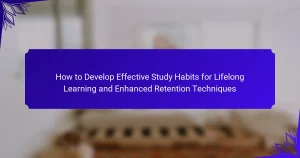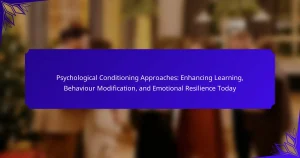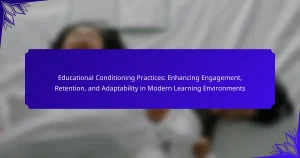Applying learning theories effectively can significantly enhance modern education and drive behavioral change. This article explores constructivism, behaviorism, and cognitivism as foundational frameworks. It highlights unique attributes like personalized learning and social interaction, while also addressing rare attributes such as neurodiversity and emotional intelligence. Finally, it discusses practical strategies for integrating these theories into lesson plans and instructional methods to improve student engagement and outcomes.
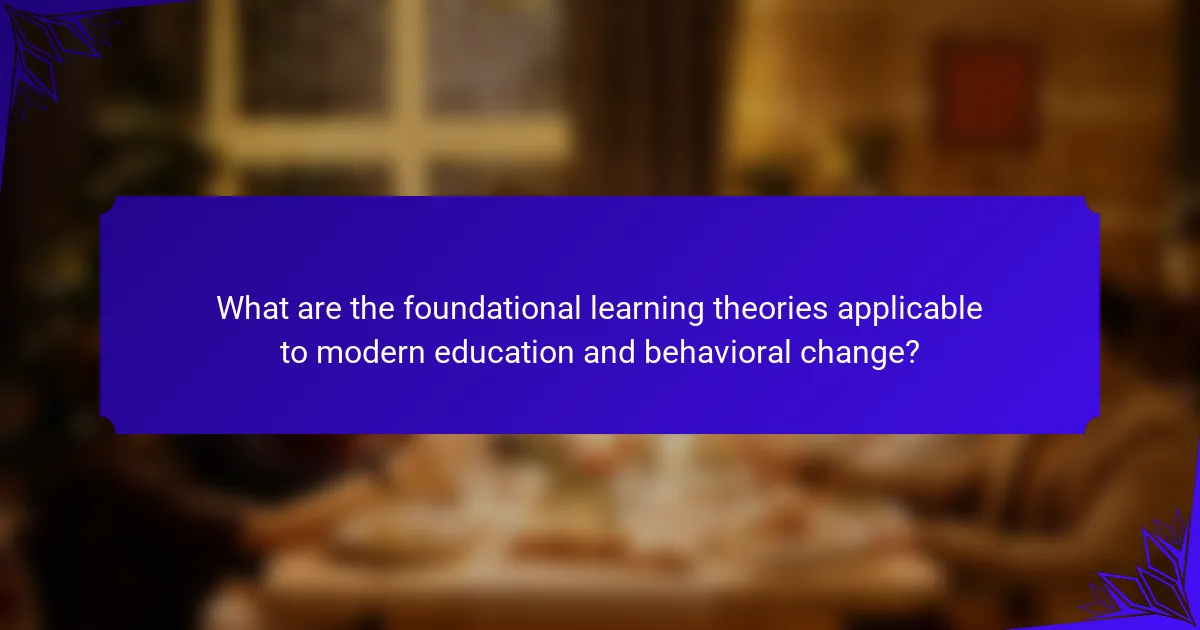
What are the foundational learning theories applicable to modern education and behavioral change?
Learning theories such as constructivism, behaviorism, and cognitivism provide foundational frameworks for modern education and behavioral change. Constructivism emphasizes active learning through experience, fostering critical thinking and problem-solving skills. Behaviorism focuses on observable behaviors and reinforcement, making it effective for skill acquisition. Cognitivism highlights the importance of mental processes in learning, guiding educators to design instruction that enhances understanding and retention. Integrating these theories can lead to more effective educational practices and transformative behavioral change.
How does behaviorism influence contemporary teaching methods?
Behaviorism significantly shapes contemporary teaching methods by emphasizing observable behaviors and reinforcement strategies. This approach promotes structured learning environments where positive reinforcement enhances student engagement and motivation.
Teachers apply behaviorist principles through techniques such as direct instruction and immediate feedback, which help solidify knowledge retention. For example, using reward systems for student achievements encourages consistent effort and participation.
Moreover, behaviorism supports the use of technology in education, enabling personalized learning experiences. Adaptive learning platforms utilize data to reinforce desired behaviors, catering to individual student needs.
In summary, behaviorism influences modern education by fostering a results-oriented framework that prioritizes measurable outcomes and effective behavioral modifications.
What are the key principles of behaviorism?
The key principles of behaviorism include reinforcement, punishment, and the importance of observable behavior. Reinforcement increases the likelihood of a behavior being repeated, while punishment decreases it. Behaviorism emphasizes that learning occurs through interactions with the environment, making it essential for effective education and behavioral change.
How can reinforcement be effectively applied in classrooms?
Reinforcement can be effectively applied in classrooms through consistent positive feedback and rewards. This approach encourages desired behaviors and enhances student engagement. For example, teachers can use praise, tangible rewards, or additional privileges to reinforce academic achievements. Implementing a clear system for recognizing effort and improvement fosters a motivating environment. As a result, students are more likely to participate actively and take ownership of their learning.
What role does constructivism play in promoting active learning?
Constructivism promotes active learning by encouraging students to build their own understanding through experiences. This theory emphasizes collaboration, critical thinking, and problem-solving, which engage learners in the educational process. Active learning techniques, such as group discussions and hands-on projects, foster deeper comprehension and retention of knowledge. By allowing learners to explore and reflect, constructivism enhances motivation and personal investment in learning outcomes.
How can educators implement constructivist strategies?
Educators can implement constructivist strategies by fostering active learning environments. These strategies include collaborative projects, problem-solving tasks, and real-world applications.
1. Encourage group discussions to promote peer learning.
2. Use project-based learning to connect concepts to practical scenarios.
3. Integrate technology to enhance interactive learning experiences.
4. Provide opportunities for self-directed learning to promote autonomy.
These approaches support deeper understanding and retention of knowledge.
What are the limitations of constructivist approaches?
Constructivist approaches have several limitations, including potential inconsistency in learning outcomes and reliance on prior knowledge. These methods may not suit all learners, particularly those needing structured guidance. Additionally, assessment of learning can be challenging, as it often emphasizes subjective measures over standardized testing. Resource availability and teacher training can also hinder effective implementation.
How does social learning theory enhance collaborative education?
Social learning theory enhances collaborative education by promoting knowledge sharing through observation and interaction. It encourages learners to engage with peers, fostering a supportive environment that boosts motivation and retention. Collaborative activities, such as group discussions and peer teaching, allow students to learn from each other’s experiences, enhancing critical thinking skills. This theory also emphasizes the role of social context in learning, making education more relevant and applicable to real-world scenarios. Ultimately, integrating social learning principles cultivates a community of learners who actively support each other’s growth.
What techniques support observational learning in students?
Modeling, reinforcement, and guided practice are techniques that support observational learning in students. Modeling involves demonstrating behaviors for students to imitate. Reinforcement encourages the repetition of observed behaviors through rewards. Guided practice allows students to apply learned behaviors with support, enhancing retention and confidence.
How can educators foster a community of practice?
Educators can foster a community of practice by promoting collaboration and shared learning among peers. This involves creating structured opportunities for educators to engage in dialogue, share experiences, and reflect on their practices.
Regular workshops and professional development sessions can enhance knowledge exchange. Utilizing digital platforms for discussion can also facilitate ongoing communication. As a result, educators build trust and a supportive environment, encouraging innovative teaching methods.
Engaging in peer observations allows educators to learn from one another’s strengths. Providing feedback in a constructive manner fosters continuous improvement. This collaborative approach ultimately leads to enhanced student outcomes and a more dynamic educational environment.

What unique attributes of learning theories can be leveraged for effective outcomes?
Leveraging unique attributes of learning theories can enhance educational outcomes. One effective attribute is the adaptability of constructivist theory, which promotes personalized learning experiences. This approach fosters deeper engagement and retention by allowing learners to build knowledge based on prior experiences. Another unique attribute is the emphasis on social interaction in social learning theory, which encourages collaboration and peer feedback, leading to improved critical thinking skills. Additionally, behaviorist principles can be harnessed through reinforcement strategies, promoting desired behaviors and motivating learners. These unique attributes collectively drive effective educational practices and behavioral change.
How can differentiated instruction be integrated into learning theories?
Differentiated instruction can be integrated into learning theories by tailoring educational approaches to meet diverse student needs. This practice enhances engagement and promotes effective learning.
For example, constructivist theories emphasize active learning, allowing educators to adapt lessons based on individual student experiences and interests. Behaviorist theories can also support differentiated instruction by using reinforcement strategies that cater to various learning paces.
Additionally, applying multiple intelligences theory enables teachers to design activities that resonate with different student strengths, ensuring that all learners can access the curriculum. This integration fosters a more inclusive educational environment.
What are the benefits of tailoring teaching methods to individual needs?
Tailoring teaching methods to individual needs enhances student engagement, improves learning outcomes, and fosters personal growth. Customized approaches address diverse learning styles, allowing for more effective knowledge retention. As a result, students are more likely to succeed academically and develop critical thinking skills. Individualized instruction can also boost motivation, as learners feel valued and understood.
What innovative technologies support learning theories in modern education?
Innovative technologies such as artificial intelligence, virtual reality, and adaptive learning systems support learning theories in modern education. These tools enhance personalized learning experiences, making education more engaging and effective. For example, AI can analyze student performance to tailor instructional content, while virtual reality offers immersive environments for experiential learning. Adaptive learning systems adjust to individual learning paces, promoting mastery of concepts. Integrating these technologies aligns with constructivist and behaviorist theories, facilitating behavioral change and improved learning outcomes.
How can gamification be used to enhance engagement?
Gamification enhances engagement by integrating game elements into educational experiences. This approach increases motivation and participation by making learning interactive and enjoyable.
Gamification can employ various techniques such as point systems, leaderboards, and challenges. These elements create a competitive atmosphere that encourages learners to progress. For example, incorporating rewards for completing tasks can boost student motivation, leading to better retention of information.
Additionally, gamification promotes collaboration among learners. Group activities and team challenges foster a sense of community, enhancing social interaction and peer learning. As a result, students are more likely to engage deeply with the content.
Using gamification effectively requires understanding the target audience and their preferences. Tailoring game elements to fit learners’ interests can significantly enhance their overall educational experience.
What role do online platforms play in applying learning theories?
Online platforms are crucial for applying learning theories, enhancing engagement and accessibility. They facilitate personalized learning experiences, allowing educators to implement behaviorist, constructivist, and connectivist approaches effectively. For instance, behaviorist theories benefit from gamification elements on platforms, reinforcing desired behaviors through rewards. Constructivist theories thrive in collaborative online environments, promoting social interaction and knowledge construction. Connectivist theories leverage the vast resources available online, enabling learners to connect with diverse information sources and experts. This integration of learning theories through online platforms ultimately fosters effective modern education and behavioral change.

What rare attributes are emerging in the application of learning theories?
Emerging rare attributes in learning theories include personalized learning pathways, neurodiversity integration, and emotional intelligence focus. These attributes enhance adaptability and inclusivity in modern education. Personalized pathways allow tailored learning experiences, while integrating neurodiversity acknowledges diverse cognitive styles. Emotional intelligence focus fosters social skills and resilience, crucial for behavioral change.
How can neuroeducation bridge the gap between neuroscience and pedagogy?
Neuroeducation bridges neuroscience and pedagogy by integrating scientific insights into teaching practices. This approach enhances learning outcomes by applying principles of brain function to educational strategies. For example, understanding neuroplasticity informs methods that promote active engagement and retention. Additionally, utilizing data on cognitive load can optimize lesson designs, making them more effective. By aligning teaching techniques with how the brain learns best, educators can foster deeper understanding and behavioral change in students.
What insights does neuroscience provide for effective teaching?
Neuroscience offers insights that enhance teaching effectiveness by aligning methods with how the brain learns. Techniques such as spaced repetition and active engagement promote retention and understanding. Understanding neuroplasticity supports personalized learning approaches, enabling educators to adapt strategies to individual student needs. Research indicates that emotional connections to material can significantly boost motivation and learning outcomes.
What are the implications of cultural responsiveness in learning theories?
Cultural responsiveness in learning theories enhances educational effectiveness by recognizing diverse student backgrounds. It fosters inclusivity, improves engagement, and supports personalized learning. By integrating cultural perspectives, educators can address unique needs, promoting equitable opportunities for all learners. This approach aligns with the root attribute of inclusivity and the unique attribute of engagement, leading to improved educational outcomes.
How can understanding cultural backgrounds improve educational outcomes?
Understanding cultural backgrounds enhances educational outcomes by fostering inclusivity and tailoring teaching methods. Culturally responsive education improves student engagement, leading to higher academic performance. Research indicates that students from diverse backgrounds thrive when their cultural identities are acknowledged and integrated into the curriculum. This approach not only boosts confidence but also encourages collaboration among peers, enriching the learning environment. As a result, educational institutions can cultivate a more equitable and effective learning experience for all students.
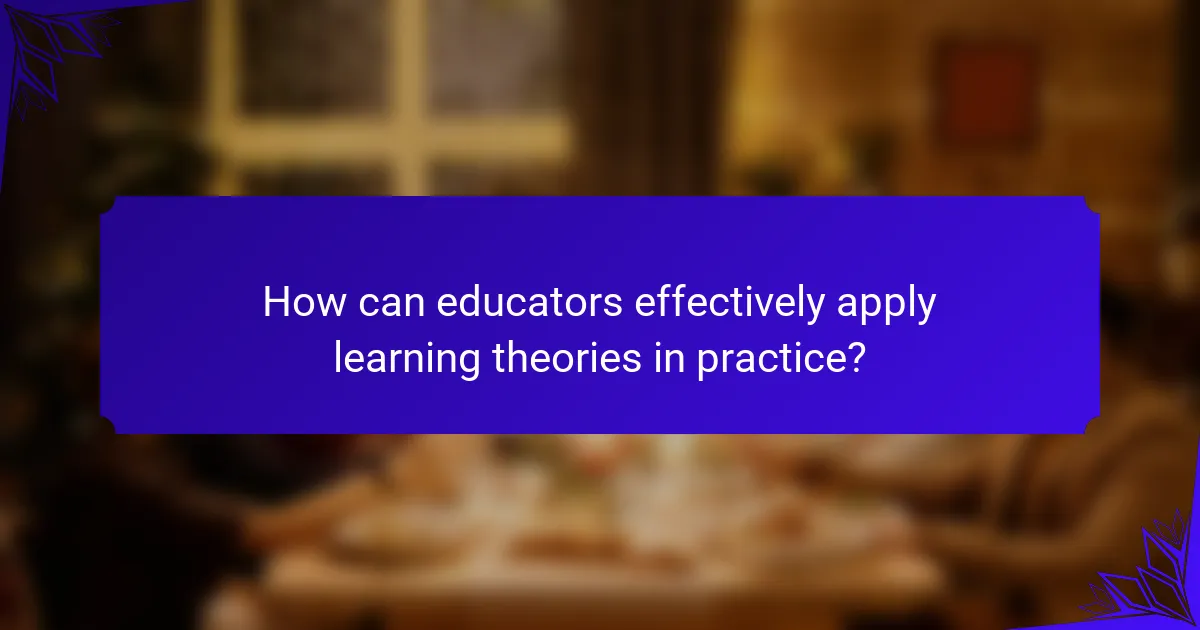
How can educators effectively apply learning theories in practice?
Educators can effectively apply learning theories by integrating them into lesson plans, utilizing diverse teaching methods, and assessing student engagement. This approach enhances understanding and retention.
Constructing lessons around established theories, such as constructivism or behaviorism, allows educators to tailor strategies that meet individual learning needs. For instance, applying constructivist principles encourages active learning through collaboration and problem-solving.
Incorporating a variety of instructional methods, such as visual aids, hands-on activities, and technology, caters to different learning styles. This multidimensional approach fosters a more inclusive classroom environment.
Regular assessment of student understanding through formative evaluations can guide instructional adjustments. By reflecting on student feedback and performance, educators can refine their strategies to better align with learning theories, ultimately driving effective behavioral change.
What are the best practices for implementing learning theories in the classroom?
To effectively implement learning theories in the classroom, educators should integrate a variety of strategies. First, align teaching methods with specific learning theories, such as constructivism or behaviorism. Second, utilize active learning techniques, encouraging student participation and engagement. Third, provide timely feedback to support student progress and understanding. Fourth, create a supportive learning environment that accommodates diverse learning styles. Lastly, continuously assess and adapt instructional approaches based on student performance and feedback.
What common mistakes should educators avoid when applying these theories?
Educators should avoid common mistakes such as neglecting individual learning styles, failing to integrate theory with practice, and overemphasizing standardized assessments. These errors can hinder effective application of learning theories. Additionally, overlooking the importance of feedback and collaboration can stifle student engagement and growth. Lastly, not adapting to technological changes can limit the effectiveness of educational strategies.
How can ongoing assessment enhance the application of learning theories?
Ongoing assessment enhances the application of learning theories by providing continuous feedback and adapting instructional strategies. This iterative process allows educators to identify student needs, adjust teaching methods, and reinforce concepts effectively. By integrating assessments aligned with learning theories, educators can create a responsive learning environment that fosters engagement and improves outcomes. This approach supports personalized learning, ensuring that each student’s unique attributes are recognized and addressed.
What methods can be used for formative assessment in learning environments?
Formative assessment methods in learning environments include observations, quizzes, peer reviews, and self-assessments. These techniques provide immediate feedback, fostering student engagement and guiding instructional adjustments. Observations allow educators to assess student behavior and participation. Quizzes gauge understanding of material in real-time. Peer reviews encourage collaboration and critical thinking. Self-assessments promote reflection on personal learning progress. Each method enhances the learning experience by identifying areas for improvement and reinforcing knowledge retention.
How can feedback loops improve student learning and engagement?
Feedback loops enhance student learning and engagement by providing timely responses that guide improvement. They create a dynamic environment where students can reflect on their performance, adjust their strategies, and actively participate in their learning journey.
Incorporating feedback loops encourages a growth mindset, fostering resilience and motivation. For instance, regular assessments paired with constructive feedback help students identify strengths and areas for development. This continuous interaction promotes deeper understanding and retention of knowledge.
Moreover, feedback loops facilitate personalized learning experiences. Teachers can tailor their approach based on individual student needs, ensuring that each learner receives support aligned with their unique challenges. This adaptive strategy significantly boosts engagement, as students feel more connected to their educational process.
Ultimately, feedback loops serve as a vital mechanism for enhancing educational outcomes, transforming passive learning into an interactive, student-centered experience.
What expert insights can guide educators in applying learning theories effectively?
Educators can apply learning theories effectively by integrating practical strategies grounded in those theories. Utilizing constructivist approaches encourages active engagement, fostering deeper understanding.
Incorporating differentiated instruction tailors learning experiences to individual student needs, enhancing motivation and retention. Regular formative assessments provide feedback, guiding instructional adjustments to meet diverse learning styles.
Collaboration among educators to share insights on theory application can lead to innovative practices. Professional development focused on current research in learning theories equips educators with tools for effective implementation.
